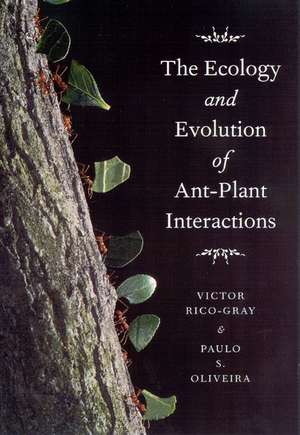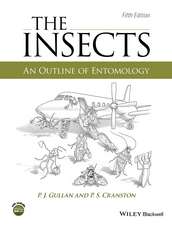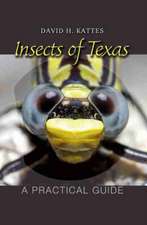The Ecology and Evolution of Ant-Plant Interactions: Interspecific Interactions
Autor Victor Rico-Gray, Paulo S. Oliveiraen Limba Engleză Paperback – 23 iul 2007
Ants are probably the most dominant insect group on Earth, representing ten to fifteen percent of animal biomass in terrestrial ecosystems. Flowering plants, meanwhile, owe their evolutionary success to an array of interspecific interactions—such as pollination, seed dispersal, and herbivory—that have helped to shape their great diversity. The Ecology and Evolution of Ant-Plant Interactions brings together findings from the scientific literature on the coevolution of ants and plants to provide a better understanding of the unparalleled success of these two remarkable groups, of interspecific interactions in general, and ultimately of terrestrial biological communities.
The Ecology and Evolution of Ant-Plant Interactions synthesizes the dynamics of ant-plant interactions, including the sources of variation in their outcomes. Victor Rico-Gray and Paulo S. Oliveira capture both the emerging appreciation of the importance of these interactions within ecosystems and the developing approaches that place studies of these interactions into a broader ecological and evolutionary context. The collaboration of two internationally renowned scientists, The Ecology and Evolution of Ant-Plant Interactions will become a standard reference for understanding the complex interactions between these two taxa.
The Ecology and Evolution of Ant-Plant Interactions synthesizes the dynamics of ant-plant interactions, including the sources of variation in their outcomes. Victor Rico-Gray and Paulo S. Oliveira capture both the emerging appreciation of the importance of these interactions within ecosystems and the developing approaches that place studies of these interactions into a broader ecological and evolutionary context. The collaboration of two internationally renowned scientists, The Ecology and Evolution of Ant-Plant Interactions will become a standard reference for understanding the complex interactions between these two taxa.
Preț: 320.60 lei
Nou
Puncte Express: 481
Preț estimativ în valută:
61.36€ • 63.24$ • 51.80£
61.36€ • 63.24$ • 51.80£
Carte tipărită la comandă
Livrare economică 03-17 martie
Preluare comenzi: 021 569.72.76
Specificații
ISBN-13: 9780226713489
ISBN-10: 0226713482
Pagini: 320
Ilustrații: 55 line drawings, 27 tables
Dimensiuni: 152 x 229 x 23 mm
Greutate: 0.48 kg
Editura: University of Chicago Press
Colecția University of Chicago Press
Seria Interspecific Interactions
ISBN-10: 0226713482
Pagini: 320
Ilustrații: 55 line drawings, 27 tables
Dimensiuni: 152 x 229 x 23 mm
Greutate: 0.48 kg
Editura: University of Chicago Press
Colecția University of Chicago Press
Seria Interspecific Interactions
Notă biografică
Victor Rico-Gray is a research scientist of ecology and Chairman of the Applied Ecology Department at the Instituto de Ecologia, A. C. in Xalapa, Veracruz, Mexico. Paulo S. Oliveira is professor of ecology at the Universidade Estadual de Campinas, São Paulo, Brazil.
Cuprins
Preface
1. Ant-Plant Interactions
The Origin and Early Evolution of Ant-Plant Associations
Phylogenetic Associations
A Brief History of the Associations
Coevolution and Interspecific Interactions
2. Antagonistic Interactions: Leaf-Cutting and Seed-Harvesting Ants
Leaf-Cutting Ants (Grazing)
Seed-Harvesting Ants (Predation)
3. Mutualism from Antagonism: Ants as Primary Seed-Dispersers
The Reward: Elaiosomes
Seed Dispersal by Ants
Myrmecochory: Distribution and Significance Worldwide
Conclusion
Appendix 3.1. Myrmecochory in Eastern North America, Japan, and Europe
Appendix 3.2. Myrmecochory in Australia and South Africa
Appendix 3.3. Myrmecochory in the Neotropics
4. Mutualism from Opportunism: Ants as Secondary Seed-Dispersers
The Reward: Fallen Fleshy Diaspores
Diaspore Attributes and Patterns of Ant Attendance
Ant Effects on Seeds and Seedlings
Directed Dispersal of Seeds by Ponerine Ants
Prospect
5. Mutualism from Antagonism: Ants and Flowers
Pollination by Ants
Discouragement of Floral Visits by Ants
Appendix 5.1. Plant Species in Which Ant Pollination Has Been Demonstrated
6. Antagonism and Mutualism: Direct Interactions
The Pseudomyrmex-Acacia Association
Ants, Plants, and Food Bodies
Ant-Inhabited Plants Offering No Direct Food Rewards
Ants, Plants, and Extrafloral Nectaries
Plant Defensive Strategies and Induced Responses
The Nature of the Associations and the Importance of Conditionality
Topics for Future Consideration
Appendix 6.1. Flowering Plants That Maintain a Nonsymbiotic Relationship with Ants
7. Antagonism and Mutualism: Indirect Interactions
Ants, Plants, and Hemipterans
Variable Outcomes in Ant-Hemipteran Systems
The Effect of Ant-Hemiptera Interactions on Host Plants
Ant-Hemiptera Associations and the Evolution of Extrafloral Nectaries
8. Nutrition of Plants by Ant Mutualists: Life History of Ant-Fed Plants and Ant-Garden Systems
Ant-Fed Plants
Ant Gardens
Conclusion
Appendix 8.1. Ant-Fed Plants That Absorb Nutrients from Ant Debris
9. Canopy-Dwelling Ants, Plant and Insect Exudates, and Ant Mosaics
Canopy Ants: Main Features and Trophic Role
The Competitive Environment
Ant Mosaics
Plant and Insect Exudates and Ant Community Structure
The Effect of Trophobiont Tenders on Associated Herbivores and on the Host Plant
10. Variation in Ant-Plant Interactions
Temporal Variation
Spatial Variation
Appendix 10.1. Plants with Extrafloral Nectaries
Appendix 10.2. Ant Species Using Plant-Derived Food Resources
11. Ant-Plant Interactions in Agriculture
Agricultural Systems, Herbivores, and Ants
Ants as Biological Control Agents
Case Studies
Biological Control and Interspecific Interactions
12. Overview and Perspectives
Literature Cited
Index
1. Ant-Plant Interactions
The Origin and Early Evolution of Ant-Plant Associations
Phylogenetic Associations
A Brief History of the Associations
Coevolution and Interspecific Interactions
2. Antagonistic Interactions: Leaf-Cutting and Seed-Harvesting Ants
Leaf-Cutting Ants (Grazing)
Seed-Harvesting Ants (Predation)
3. Mutualism from Antagonism: Ants as Primary Seed-Dispersers
The Reward: Elaiosomes
Seed Dispersal by Ants
Myrmecochory: Distribution and Significance Worldwide
Conclusion
Appendix 3.1. Myrmecochory in Eastern North America, Japan, and Europe
Appendix 3.2. Myrmecochory in Australia and South Africa
Appendix 3.3. Myrmecochory in the Neotropics
4. Mutualism from Opportunism: Ants as Secondary Seed-Dispersers
The Reward: Fallen Fleshy Diaspores
Diaspore Attributes and Patterns of Ant Attendance
Ant Effects on Seeds and Seedlings
Directed Dispersal of Seeds by Ponerine Ants
Prospect
5. Mutualism from Antagonism: Ants and Flowers
Pollination by Ants
Discouragement of Floral Visits by Ants
Appendix 5.1. Plant Species in Which Ant Pollination Has Been Demonstrated
6. Antagonism and Mutualism: Direct Interactions
The Pseudomyrmex-Acacia Association
Ants, Plants, and Food Bodies
Ant-Inhabited Plants Offering No Direct Food Rewards
Ants, Plants, and Extrafloral Nectaries
Plant Defensive Strategies and Induced Responses
The Nature of the Associations and the Importance of Conditionality
Topics for Future Consideration
Appendix 6.1. Flowering Plants That Maintain a Nonsymbiotic Relationship with Ants
7. Antagonism and Mutualism: Indirect Interactions
Ants, Plants, and Hemipterans
Variable Outcomes in Ant-Hemipteran Systems
The Effect of Ant-Hemiptera Interactions on Host Plants
Ant-Hemiptera Associations and the Evolution of Extrafloral Nectaries
8. Nutrition of Plants by Ant Mutualists: Life History of Ant-Fed Plants and Ant-Garden Systems
Ant-Fed Plants
Ant Gardens
Conclusion
Appendix 8.1. Ant-Fed Plants That Absorb Nutrients from Ant Debris
9. Canopy-Dwelling Ants, Plant and Insect Exudates, and Ant Mosaics
Canopy Ants: Main Features and Trophic Role
The Competitive Environment
Ant Mosaics
Plant and Insect Exudates and Ant Community Structure
The Effect of Trophobiont Tenders on Associated Herbivores and on the Host Plant
10. Variation in Ant-Plant Interactions
Temporal Variation
Spatial Variation
Appendix 10.1. Plants with Extrafloral Nectaries
Appendix 10.2. Ant Species Using Plant-Derived Food Resources
11. Ant-Plant Interactions in Agriculture
Agricultural Systems, Herbivores, and Ants
Ants as Biological Control Agents
Case Studies
Biological Control and Interspecific Interactions
12. Overview and Perspectives
Literature Cited
Index
















